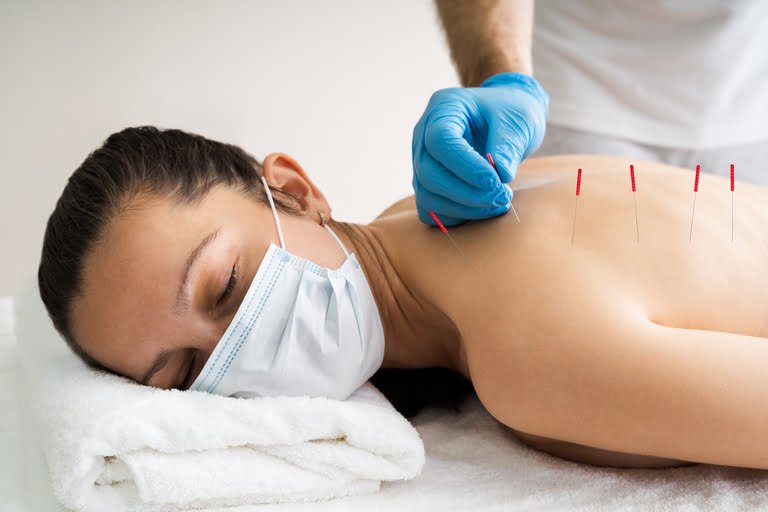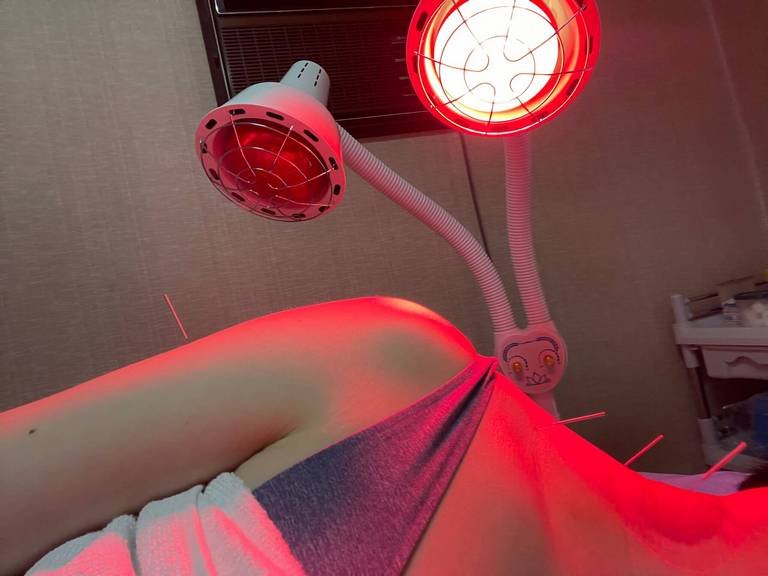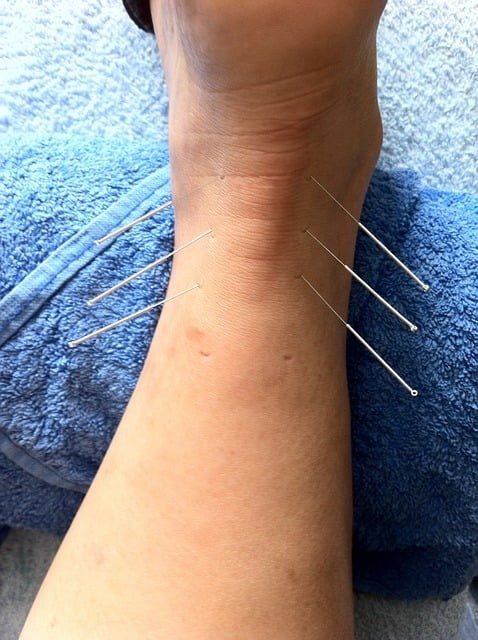Dry Needling
We accept Medicaid, Medicare and most health insurance plans
Table Of Contents
- What is dry needling?
- What is a trigger point?
- How does dry needling work?
- What does dry needling do?
- When and what dry needling is used for?
- Who shouldn’t get dry needling treatments
- Benefits of dry needling procedure
- The type of needles we use for the procedure
- Deep vs Superficial dry needling
- Mechanisms of action
- Revitalize Your Muscles: Unleash the Power of Dry Needling!

What is dry needling?
Dry needling – is a procedure in which a trained professional inserts thin, sterile needles into trigger points in muscles in various parts of the body. The needles are called «dry» because no drugs or substances are injected with them. After the injection, a localized cramp response – an involuntary contraction of muscle fibers – may occur. It helps relieve muscle tension and deactivate the trigger point.
The purpose of a dry injection is to relieve muscle tension, improve blood flow and reduce pain. The procedure is virtually painless, is usually well tolerated by patients, and can be an effective adjunct to other physical therapy or rehabilitation programs.
A specialized form of the procedure – functional dry needling. It focuses on the treatment of dysfunctional muscles and their associated movement patterns. This technique is primarily used by physical therapists and other healthcare professionals to address musculoskeletal conditions and improve functional movement.
What is a trigger point?
A trigger point is an area in a muscle that is hypersensitive to touch. Sensitivity means pain, tension or referred sensation to other parts of the body. The latter is worth discussing separately.
When a trigger point is pressed, a person may feel pain or discomfort in other areas far away from the trigger point. These are called referred sensations. For example, a trigger point in the shoulder muscle may cause pain that spreads down the arm.
Here are some of the most common causes of trigger points:
- Static and dynamic overuse of the muscle;
- trauma;
- poor posture;
- repetitive motion.

How does dry needling work?
- The local twitch response triggers the release of endorphins, which are the body’s natural pain-relieving chemicals. This provides immediate pain relief.
- The needle insertion improves blood flow to the targeted area, increasing the oxygen and nutrient supply to the muscles, which aids in tissue healing and repair.
- The micro-injury caused by the needle also initiates the body’s natural healing process, promoting tissue remodeling and reducing scar tissue formation.
- From a biochemical perspective, the process modulates the levels of various neurotransmitters and inflammatory markers in the affected tissues, contributing to pain reduction and improved muscle function.
Overall, the physiological and biochemical effects combine to relieve muscle pain, reduce tension, and enhance the body’s natural healing mechanisms, making it an effective therapy for various musculoskeletal conditions.
What does dry needling do?
Dry needling therapy can be beneficial for various musculoskeletal conditions and pain-related issues. Here are some of the diseases and conditions that procedure can help with:
- back pain and neck pain;
- shoulder pain and frozen shoulder;
- headaches and migraines;
- tendinitis;
- tennis and golfer's elbow;
- joint issues;
- disk issues;
- knee pain and patellofemoral pain syndrome;
- whiplash hip pain and sciatica;
- muscle strains and sprains;
- fibromyalgia and myofascial pain syndrome;
- pelvic pain;
- sports injuries and overuse injuries;
- spinal issues;
- chronic pain conditions;
- night cramps;
- muscle spasms;
- phantom limb pain.
Please note that the appropriateness of dry needling for specific conditions may vary from individual to individual. It's crucial to consult a qualified healthcare professional to determine if dry needling is a suitable treatment option for your particular health needs.

When and what dry needling is used for?
Here are the main symptoms and conditions for which dry acupuncture can help as part of a comprehensive therapy.
Musculoskeletal pain. Individuals with musculoskeletal pain, such as back pain, neck pain, shoulder pain, knee pain and various other muscle-related discomforts, may benefit from dry needling.
Myofascial trigger points. Those with myofascial trigger points, which are localized areas of muscle tightness and tenderness, can find relief through dry needling.
Limited range of motion. The procedure can help improve range of motion and flexibility in muscles that have become stiff or tense.
Sports injuries. Athletes or active people with sports-related injuries, muscle strains, or overuse injuries might benefit from dry needling physical therapy as part of their rehabilitation program.
Chronic pain conditions. People with chronic pain conditions, like fibromyalgia, may experience pain relief and improved muscle function.
Post-surgery rehabilitation. Procedure can be incorporated into post-surgery rehabilitation programs to promote healing and relieve muscle tension.
Complementary therapy. Dry needle can complement other physical therapy or rehabilitation techniques, enhancing overall treatment outcomes.
Who shouldn't get dry needling treatments
The procedure is not suitable for everyone. Here are some examples of when the procedure should not be used. Be sure to consult with your physician before seeking this service.
- Infections or skin conditions. Dry needling should be avoided in areas with active infections or skin conditions to prevent complications.
- Bleeding disorders. People with bleeding disorders or those taking blood-thinning medications might be at higher risk of bleeding or bruising.
- Pregnancy. Although there is no strong evidence suggesting harm, some practitioners may avoid dry needling during pregnancy, especially in the first trimester.
- Immunocompromised individuals. People with compromised immune systems should exercise caution, as dry needling carries a small risk of infection.
- Uncontrolled medical conditions. Individuals with uncontrolled diabetes or hypertension should consult their healthcare provider before considering a procedure.

Benefits of dry needling procedure
Dry needling has a holistic effect with the following main benefits.
- pain reliefby releasing tension in trigger points and promoting the release of endorphins, the body's natural painkillers;
- muscle relaxation, reducing muscle spasms and improving flexibility and range of motion;
- improved blood circulation, enhancing the supply of oxygen and nutrients to the treated muscles, aiding in tissue repair and recovery;
- enhanced body's natural healing response, promoting tissue remodeling and reducing scar tissue formation
- non-medication approach – a drug-free alternative for managing pain, which can be especially beneficial for individuals seeking non-pharmacological treatments;
- improved physical well-being and quality of life by reducing pain and improving muscle function.
The type of needles we use for the procedure
Special thin filiform needles are used for the procedure. They are very thin and flexible, yet firm, so they can be inserted precisely into damaged muscles with virtually no pain. The thinner varieties are for superficial muscles, while the longer and thicker ones are for deep insertion. Filiform needles are disposable and manufactured to all medical device standards, making them hygienic and safe.

Deep vs Superficial dry needling
Deep and superficial dry acupuncture are two variations of the same therapeutic technique. They differ in the depth of action on the muscle tissue and the intended effect. Here are their main differences.
- Deep acupuncture. The specialist inserts needles quite deeply – in the muscle belly or near the bone. The goal of the procedure is to relieve chronic muscle tension, tightness, and eliminate complex and long-standing trigger points. Deep dry acupuncture requires a highly skilled practitioner and precision, and is performed by experienced medical professionals who have undergone specialized training.
- Superficial acupuncture. The practitioner inserts needles into the more superficial layers of muscle tissue, usually closer to the surface of the skin. The treatment aims to stimulate nerves and activate local circulation to reduce pain, relieve tension and speed tissue healing. Superficial acupuncture can be performed by a wide range of health care providers.
Mechanisms of action
Muscle relaxation
Pain reduction
Improved blood flow
Normalization of nervous system
Release of knots and adhesions
Enhanced range of motion
Complements physical therapy
Drug-free alternative

Revitalize Your Muscles: Unleash the Power of Dry Needling!
If you’re seeking an effective and non-invasive solution to alleviate muscle pain, tension, and discomfort, look no further than the transformative benefits of dry needling.
At Colorado Health Clinic, we pride ourselves on delivering top-notch dry needling services, tailored to your unique needs and goals. Our skilled practitioners are committed to providing a safe and compassionate environment, ensuring you feel at ease throughout the process.
Take the first step towards revitalizing your muscles and reclaiming a pain-free life! Contact our clique today and schedule your dry needling session.
Proudly Serving Colorado
improve the quality of life of our patients.

